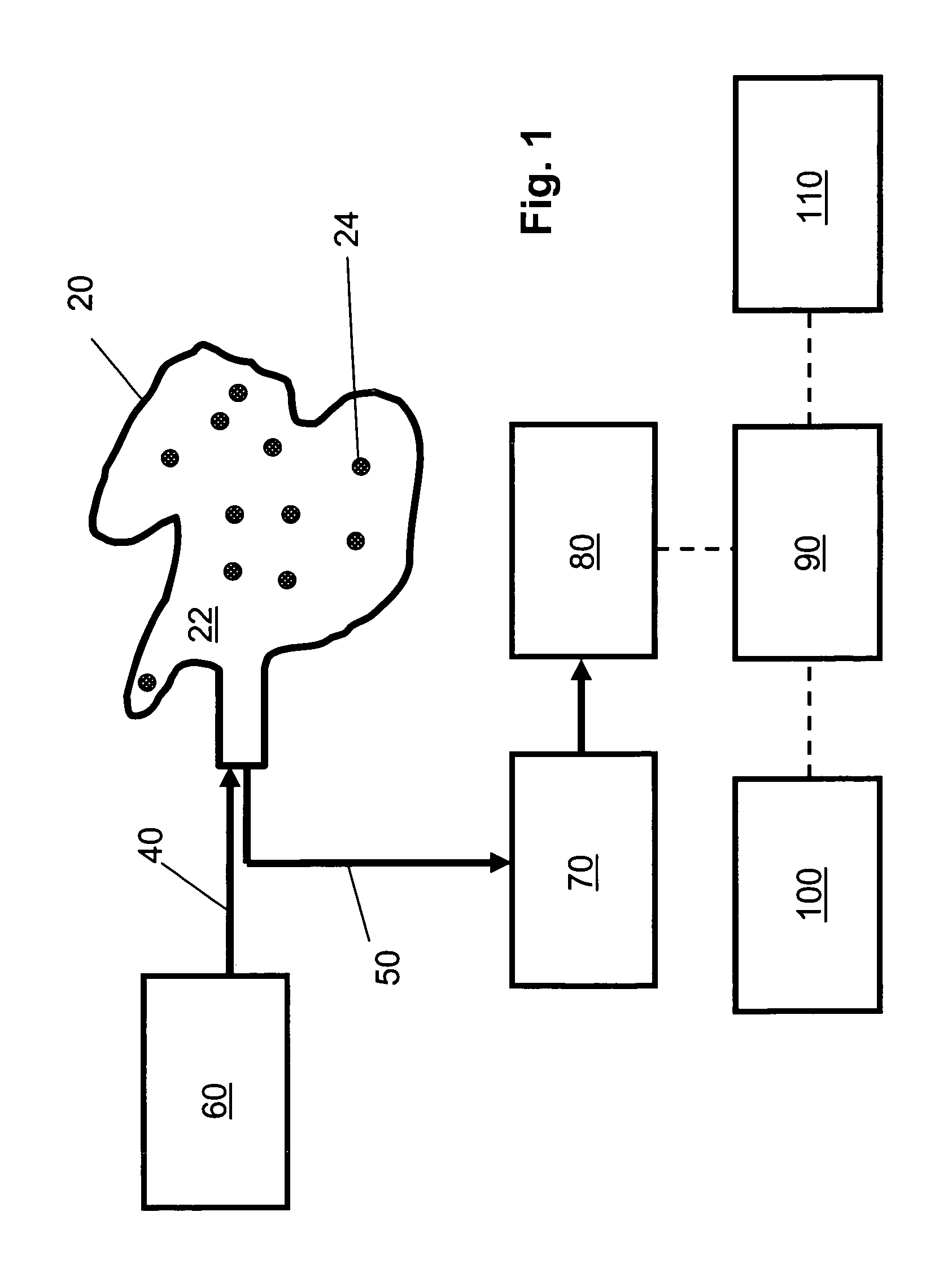Invasive chemometry
a chemometric and in vivo technology, applied in the field of in vivo chemometric analysis, can solve the problems of patient discomfort, sample loss or misidentification, and inconvenience of sample collection
- Summary
- Abstract
- Description
- Claims
- Application Information
AI Technical Summary
Benefits of technology
Problems solved by technology
Method used
Image
Examples
example 1
[0129]FIG. 1 is a schematic diagram of an embodiment of the non-invasive chemometric analysis device described herein. In FIG. 1, a probe 20 has a surface 22 that can be applied to a vascularized surface of an animal. Multiple holes 24 extend through the surface, through which radiation can pass (e.g., through air, a lens, or one or more optical fibers in the hole). In the embodiment shown in FIG. 1, optical fibers for illumination 40 are optically coupled with a radiation source 60 and pass through the holes 24 in the probe 20 to illuminate whatever lies adjacent the surface 22. Optical fibers 50 for collecting light reflected, emitted, or scattered from whatever lies adjacent the surface 22 are optically coupled to a detector 80, optionally by way of an optical element 70 such as a tunable filter or an interferometer. The detector 80 assesses light transmitted thereto by the optical fibers 50 to determine an optical property corresponding to discrete regions of space adjacent the ...
example 2
[0133]Blood Glucose Determination
[0134]The invention described herein provides an integrated method to perform a non-invasive, rapid measurement of the body chemistry of a conscious or unconscious person. The method involves using a small multipoint probe inserted under the tongue or into another vascularized tissue-lined body surface or cavity. The probe can perform several measurements simultaneously (e.g., under computer control) at several points without a need to move the probe. Several features of the probe, where and how it is located and the laser excitation wavelength used, can be routinely optimized for Raman scattering assessment of glucose and other blood components. Known spectral unmixing and other software algorithms can be applied to the acquired Raman data and enhance the selectivity and sensitivity of the methods for detection and quantification of analytes. Such enhancements can improve the accuracy and reduce the time between sampling and production of an analysi...
example 3
[0139]Assessment of a Tissue Component in One or More Tissues
[0140]The devices described herein assess optical properties at multiple body locations. A plurality of tissue types can therefore be assessed simultaneously using the devices, the number of assessable tissues depending on the number of tissue types that are contacted by or in close opposition to a radiation-collecting optical conduit of the device. Careful placement of an optical probe described herein by a skilled operator can increase or decrease the likelihood that a particular tissue type will be contacted by the probe. Furthermore, if desired, probes can be constructed to maximize the likelihood that the probe will contact a tissue of interest when the probe is applied to or inserted into the body of an animal.
[0141]FIG. 6 illustrates assessment of one or more tissue components in multiple tissue types. The device used in the analysis illustrated in FIG. 6 includes an elongate probe 20 that, in FIG. 6, is emplaced in...
PUM
 Login to View More
Login to View More Abstract
Description
Claims
Application Information
 Login to View More
Login to View More - R&D
- Intellectual Property
- Life Sciences
- Materials
- Tech Scout
- Unparalleled Data Quality
- Higher Quality Content
- 60% Fewer Hallucinations
Browse by: Latest US Patents, China's latest patents, Technical Efficacy Thesaurus, Application Domain, Technology Topic, Popular Technical Reports.
© 2025 PatSnap. All rights reserved.Legal|Privacy policy|Modern Slavery Act Transparency Statement|Sitemap|About US| Contact US: help@patsnap.com



